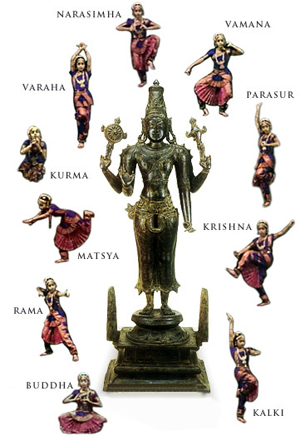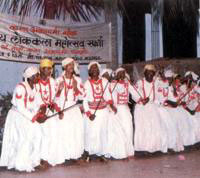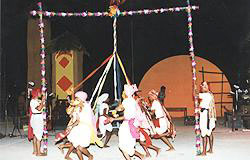|
|
Goa Dances
......................................................................................................................
|
|
Goa has a unique cultural heritage, rich
and lively and it is known for several folk festivals and
performances. The traditional folk music and dances have
continued uninterruptedly, while the influence of the
Portuguese music and dance on the local culture has helped
evolve new forms. This happy blending and co-existence of
cultural traditions gives a unique character to the music and
folk dances of Goa. The famous folk dances and forms of Goa
include Talgadi, Goff, Tonya Mel, Mando, Kunbi dance, Suvari,
Dasarawadan, Virabhadra, Hanpeth, Gauda jagar, Ranmale, Fugadi,
Ghode Modni, Lamp Dance, Musal Dance, Dhangar Dance, Dekhni
and Dhalo. |
|
|
|
Dashavatara
The term Dashavatara refers to the ten incarnations of
Lord Vishnu ('Das' means ten, 'Avatar' means
incarnations). Scholars are divided into two groups as
far as the origin of the dance is concerned. One group
believes it to have evolved from "Yakshagana", another
group considers it to have emerged from "Kuchipudi".
Many actors believe that Dashavatara is originally a
dance form from Kerala, and they worship a deity of the
Walaval region of Kerala. Whatever the source may be,
the form was introduced to the Konkan region in the 16th
century. The subject of the theft of the 'Vedas' is
discussed by the "Sutradhar" (stage manager), 'Brahmin'
figures, women actors representing the rivers, actors
playing Lord Brahma (the Creator) and Goddess Saraswati
(the goddess of learning), and the demon Shankhasur. The
overture continues for about two hours, and the proper
drama known as "Akhyana" begins after this. The play,
concerning itself |
 |
|
|
with stories
from the epics and mythology, concludes at sunrise. The red
and white makeup of Dashavatara actors distinguishes them from
the spectators who arrive shortly before 11.00 pm for the
performance. The evening commences with prayers to Ganapati or
Ganesha (the elephant-headed god), sung by the Sutradhar
(stage manager).
Dekhni
Another form of popular folk dance, the dekhni represents an
attractive mixture of folk culture and Western music, danced
mostly by Christian girls in fully Indian dress. The gestures
in the dance appear to have been borrowed from the Kathak and
Bharata Natyam. Dekhni in Konkani language means "bewitching
beauty". This song-cum-dance performed only by women to the
accompaniment of folk drum "Ghumat", displays a rare blend of
Indian and Western cultures. The dance enacts the life of a "Devdasi"
(literally meaning servant of God) girl whose job is to
perform dance in temples and social ceremonies like weddings.
The theme is of a Devdasi girl who comes to a riverbank to
take a ferry to reach the other side where she has an
appointment to dance in a wedding. She requests the adamant
boatman for a favour and is even ready to offer him her golden
earring for taking her across urgently. The dance set to
western rhythms and Indian melody, is livened up by the
conversation between the girl and the boatman in the form of a
lilting song, which lingers in the mind for a long time. The
dancers carry pantis (small clay lamps with a wick floating in
oil) or aartis. Only two or three dekhni songs, composed and
scored a long time ago, are present.
Dhalo
One of the most popular rural dances, Dhalo is performed by
women folk on the moonlit night of Hindu 'Pausha' month. This
dance is performed during the week-long festivities are held
at night time and the main deities propitiated on the occasion
are Mother Earth and Sylvan deity, who are supposed to protect
their households. This dance is slow. The songs are in Konkani
and Marathi. Normally 12 - 24 women assemble after the dinner
at a pre-selected specific spot called 'Mand' in the courtyard
of a house in the village. They arrange themselves in 2
parallel rows of 12, facing each other, and in a tribal
fashion form a link within themselves with an
arm-around-the-back arrangement, singing in unison. Normally,
two rows of women confront each other by prancing forward and
backward while singing the stories of their life and the
contemporary society. The songs cover religious and social
themes. The dance goes on every night for a week. On the
concluding day, women sport all sorts of fancy dresses and
even caricature men folk. |
|
|
|
Dhangar
Dhangars, a shepherd community believed to have migrated
from Kathiawar region of South Gujarat and settled in
the hilly northwestern fringes of Goa, are very pious
and worship the God called "Bira Deva". During Navaratri
(literally meaning 'nine nights') festival, the leader
of the house observes abstinence and fast, takes bath at
early hours in the morning, milks his share of lone one
cup of milk per day and prays and dances before the
family deity. On the tenth day, after a feast, all the
families take out their family idols to an open space in
the village, called 'Mand' and perform a |
 |
|
|
vigorous
session of dance accompanied by song. The dance begins with a
slow beat and simple footwork to the accompaniment of Dhol,
cymbals and a long flute called 'Pawa'. Their traditional
songs centre on the love story of the Hindu God Krishna and
his beloved Radha. The Kathiawari-styled white dress and
turban in this dance point to their ancestral lineage.
Fugdi
This is a group dance for women, with two major variations: as
danced in a circle or by a rows of dancers. Broadly, villages
have a dance in a circle but forest settlements have it in
rows. A few fixed steps and hand gestures and hand laps are
the elements. No instrument or musical accompaniment is found
with the dance, but special fugdi songs are innumerable. The
songs might be about Puranic stories, family life, complaints,
rivalries or people. Fugdis of different types are danced by
women at festivals like the Dhalo or Ganesh Chaturthi. A
striking variation is the kalashi fugdi before Goddess
Mahalakshmi during the vrata (disciplinary observance vowed to
some diety) offered to that goddess. This is accompained by no
songs, but the dancers carry the large vessels called kalashi
or ghagar and blow into them rhythmically as they spin around.
Altogether twenty-seven types of fugdi have been found in Goa.
A distinctive style of fugdi is found among the Dhangar
(shepherd community) women. No songs go with it and the two
women join crossed hands and spin around together, bending and
swaying to a distinct rhythm. Among the more unusual forms is
the naked fugdi peculiar only to Goa. A woman may vow to some
deity that she would dance the naked fugdi in some boon,
usually a child to a woman friend, is granted. If a child is
born then, on the sixth day from the birth, in the mother's
confinement room the naked fugdi is danced behind closed
doors.
Ghodemodni
This folk dance is performed in some parts of the talukas of
Goa, which lie near the northern boundaries of Goa. It
represents the horse (ghode) mounted cavalier, setting off to
war. Ghode Modni (‘Ghode’ means ‘horse’ and ‘Modni’ means
‘gyrations and dance-like movements’) is literally a dance
involving horse-like movements. It is a spectacular
warrior-dance commemorating the victory of the Ranes, the
Maratha rulers of the Sattari taluka in Goa, over the
Portuguese. The costume is like that of a Rajput chieftain but
the head dress used is a Peshwai puggree worn by the Maratha
rulers. The kshatriya dancers also wear head gears made of
colourful flowers, done in full traditional livery, fix at the
waist effigy of a wooden horse beautifully bridled and
decorated with colourful clothes, and carry ghungurs in the
anklets. Holding the bridle in one hand and brandishing a
naked sword with the other hand, the dancers move forward and
backward to the beat of drums, Dhol, Tasha and Cymbals to
recreate the prancing of war horses. Two or eight dancers,
fastened inside hobby-horses below their waist, brandishing
swords, execute their war like dance to the beat of the dholak
and tasha. There are no accompanying songs. The dancers go as
far as the village limits and return while executing this
exotic folkdance. The influence behind this seems to be
entirely northern. This dance is popular in Bicholim, Pernem
and Sattari talukas once ruled by the Marathas. It is mostly
performed during the Shigmo festival. |
|
|
|
Goff
Goff is an exotic confluence of colorful cultural
strands. The weaving of the plait - Goff - represents
the quite but conscious assimilation of the impressions
left behind by several dynasties, which ruled over Goa
during the past centuries. The dance is annually
presented by the peasant community in Canacona, Sanguem
and Quepem taluka in the Shigmo festival. It is a folk
dance with cords, manifesting joy and happiness of Goan
peasants after a bountiful harvest. Each dancer holds a
colourful cord |
 |
|
|
hanging at
the centre point of the 'mand' and starts dancing intricately
with the others, forming a beautiful, colourful, intricate
braid at the end of the first movement. The music starts again
and the dancers reverse the pattern of dancing so skillfully
that the braid gets unravelled and at the end of the second
movement, all the cords are loose and single once again. There
are 4 different braids of Goff. The songs sung are devoted to
Lord Krishna. Ghumat, Simel and other melodic instruments
accompany the dance. Goff has an affinity with tribal dance
forms of Gujarat.
Kunbi
Kunbis, the earliest settlers of Goa, are a sturdy tribal
community mostly settled in Salcete taluka, who though
converted to Christianity, still retains the most ancient folk
tradition of the land. Their songs and dance belonging to the
pre-Portuguese era are uniquely social and not religious. The
fast and elegant dance by a group of Kunbi women dancers,
wearing traditional yet very simple dresses, lends a colourful
touch to this ethnic art form.
Mando
The Mando is very popular among the Christian community in Goa.
In the grandest of traditions, the mando-singer was invited
specially on occassion of a wedding or some grand celebration.
He would compose special mandos in honour of the bridal
couple, whose qualities were described in detail in the mando.
Expert musicologists opine that the dhulpad, a part of the
mando, with a very quick tempo, came into general use first
and the mando with the medium tempo later. The dhulpad was
sung simply as a relaxation to the sole accompaniment of the ghumat (traditional Goan percussion instrument); the violin
and the guitar which are now regular components were
incorporated later. The dhulpad has its roots in Goan folk
music and the mando as a whole has evolved and developed from
these traditional folk music roots. The mando-dhulpad singing
thus has the original nature of folk songs from Goa but has
evolved with the music brought by the Portuguese. The lovely
mixture of Goan folk music and Church music that makes up the
mando is still very popular in Goa. There is a special Mando
festival held every year which attracts a large number of
entries from all over the state along with appreciating
audiences.
Musalam Khel
It is certain that the Pestle dance came into Goa during the
Kadamba dynasty, established in Goa A.D. 980 and 1005. There
is a belief that it was first performed before the gate of the
fort in their capital of Chandrapur (modern Chandor), in
celebration of the victory of the Vijayanagar prince Harihar
over the Cholas. The Christians of Chandor keeps up a
tradition by performing this kind of dance annually. Their
costumes for the occasion are in the Yadavas style. The
Shivalinga symbol is brandished and waved in the dance,
dancers with burning torches accompany it. At the end of the
dance, a devdasi girl dances up with water and brooms and
sweeps the ground danced over and smoothens wet clay or cow
dung over it. She receives a customary fee. All this is at the
main, public location of the dance; but the troupe proceeds,
like the mel troupes in the Shigma, to perform in the
courtyard of one house after another. They sing a verse that
announces the coming of the dance to the house and ask a lamp
to be brought out. Though Chandor is almost entirely Christian
in population, it retains memories and vestiges from the Hindu
regime of the Kadambas, seen on the occasion of the Musalam
Khel. |
|
|
|
Veerabhadra
The Veerabhadra is the festival of performance in an
entirely South Indian style. One actor is made up to
represent Veerabhadra, who according to Hindu mythology,
was created from the matted hair of Shiva at the time of
devastation of Daksha's sacrifice. He dances with two
swords in his hands; two main supporters dance at his
side; and a whole group supports them with dancing and
musically timed
|
 |
|
|
shouts. The dholak and the tasha (respectively a two
sided wooded drum and one sided copper drum played with
sticks) are the percussion accompaniments. The costumes are
Kannada style and the turbans are Mysore style. The beat is
marked during the dance in characteristically southern style
with syllables such as tha-thai-ya, thak-thai-ya. Veerabhadra
is performed once a year, as a religious observance, in some
parts of Ponda district and some of Sanguem. Apart from these
Veerabhadra is performed only in Sanquelim. On the night of the
observance, the play Dakshakanya Sati is performed and towards
the end, as a final part of the play, Veerabhadra enters. As
soon as he does the characters run off the stage, leaving the
actor to perform.
Ranamale
This is a form similar to the Ramlila in the north of India.
It renders the story of Rama in its particular way. Ranamale
does not extend beyond Sattari taluka and some parts of
Sanguem taluka Indeed the mass mind does not seem to carry a
strong impression of the story of Lord Rama. Apart from songs
related to wedding ceremonies, folk songs seems to be full of
the story of Krishna, of other tales of the Mahabharata and of
Vitthala and Rakhumai. It is said that the episode of Rama's
killing the demoness Tratika is rendered in some places, the
performances are found nowhere but the the temple of Mhalsa at
Mardol. There is a little dancing; there is however, a special
dance in a martial mood for battle scenes. The accompaniment
is shamel (a wooden percussion instrument) and zanj (a kind of
cymbals); occasionally the ghumat is added. The form is
thoroughly influenced by the Yakshagana of Karnataka. The
Sutradhara enters first; in this form he is called a Bhagavat.
Next comes a humorous character called Kodangi; it is
traditional for this jester to dance the phugdi. These two
characters remain on the stage throughout the performances and
the shift properties of the scenes. The costumes are colourful
and picturesque. Neither form of khel admits women; females
role are played by men made up like women. It is held that the
dramatic form of tiyatra (from "theatre") on the Konkani stage
today evolved from the khel.
Divlyan Nach or Lamp Dance
Balancing brass lamps with burning wicks (Divli) on heads
while indulging in slow dance movements is another form of
entertainment typical to some South Goan villages. The Divlyam
Naach re-supposes cohesion of movements on the part of all the
members of the group. It calls for tremendous self-discipline.
This dance derives its name from brass lamps used in the dance
during the Shigmo festival. The accompanying instruments
include Ghumat, Shamel, Cymbal and Harmonium. The performers
indulge in a slow dancing movement, balancing brass lamps with
burning wicks on the head and the hands. The balancing act
controlled by tremendous self-discipline and exquisite
footwork matching with the rhythms of the traditional folk
songs are eye-catching. This group dance is popular in the
southern and central Goa. |
|